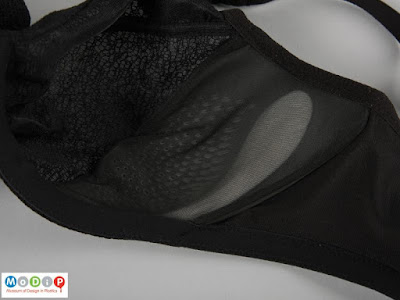MoDiP’s current exhibition, Being me: plastics and the body, contains one case focusing on shaping the body looking at some of the ways in which plastics have been used to change the appearance of the human form. As an example, we chose to feature the Wonderbra, an instantly recognisable and iconic bra that was designed to create a deep plunge cleavage whilst at the same time providing good support. It was invented by Louise Poirier in 1964 for the Canadian Lady Corset Company and was originally named the 1300.
By June 1998, when the programme was first broadcast, Charnos had, up to that point, invested £2.5 million, but the bra was still only available in one size in either black or white. Contrasted against typical development costs of £0.5 million which could produce 25 bras in a variety of sizes and colours, it was the largest investment the company had ever made on research and development for a single product.
After continued extensive testing including tool moulding trials, load and stress performance, creep measurement, durability, consumer opinion as well as constant refinement in response to all of the research generated, the Bioform was finally launched in October 2000. Available to buy in all major UK department stores in a full range of sizes, it quickly became a best-seller. Prior to the launch, Charnos had received £3 million worth of advance orders, interest from manufacturers wanting to licence the product and a contract with Marks and Spencer to create their own branded version.
Unfortunately, despite this early success, the cost of production became so high that within three years Charnos had been bought out, the organisation restructured and the Bioform gradually phased out so that now it is only available to buy in online shops. Having read favourable user reviews, I am interested to acquire one to try for myself. Apparently, it takes some time to get used to wearing as the design is so radically different to anything that has been available before. But the story helps to demonstrate how we often perceive plastics to be a cheap material because the end product we can access is made available to us at such a reasonable cost. What we do not see is the hidden price of the concept, design, research, development and testing, which in this case amounted to several millions of pounds.
Katherine Pell, Collections Officer
Another revolutionary bra in MoDiP’s collections that did not make it into the exhibition is the Bioform bra. What is particularly interesting about this object is the inclusion of a plastics armature to provide the support, which is just visible in the image below.
The story behind this revolutionary new design began in 1997 as a result of a series of programmes made for Channel 4 following two product designers: Richard Seymour and Dick Powell. Looking at everyday design, one of the challenges was to consider the complex engineering problem of the bra. UK lingerie manufacturer Charnos set the brief to create a bra for the larger sized bust that would be supportive and comfortable but also attractive – something they felt was lacking in the designs available at that time.
 |
The aerobie flying ring.
Picture credit: https://aerobie.com/
|
After considerable research, including user experience workshops, the designers chose to focus on improving the underwire; the thin strip of rigid material sewn into the bra fabric, beneath each cup. Inspired by the aerobie flying ring (seen in the image above), which has a polycarbonate inner core with softer rubber moulded either side, Seymour and Powell thought they could replicate this idea within a 3-dimensional plastic support. They produced a prototype comprising a polypropylene rigid core over-moulded in a soft and flexible TPE (thermoplastic elastomer), perforated for breathability.
 |
The illustration above references the shape of the Bioform armature: part 22 is the rigid, inner core, part 28 the soft, flexible outer.
|
After continued extensive testing including tool moulding trials, load and stress performance, creep measurement, durability, consumer opinion as well as constant refinement in response to all of the research generated, the Bioform was finally launched in October 2000. Available to buy in all major UK department stores in a full range of sizes, it quickly became a best-seller. Prior to the launch, Charnos had received £3 million worth of advance orders, interest from manufacturers wanting to licence the product and a contract with Marks and Spencer to create their own branded version.
Unfortunately, despite this early success, the cost of production became so high that within three years Charnos had been bought out, the organisation restructured and the Bioform gradually phased out so that now it is only available to buy in online shops. Having read favourable user reviews, I am interested to acquire one to try for myself. Apparently, it takes some time to get used to wearing as the design is so radically different to anything that has been available before. But the story helps to demonstrate how we often perceive plastics to be a cheap material because the end product we can access is made available to us at such a reasonable cost. What we do not see is the hidden price of the concept, design, research, development and testing, which in this case amounted to several millions of pounds.
Katherine Pell, Collections Officer


No comments:
Post a Comment
Note: only a member of this blog may post a comment.